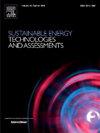船用燃料氨安全性评价的硅分散模型
IF 7.1
2区 工程技术
Q1 ENERGY & FUELS
Sustainable Energy Technologies and Assessments
Pub Date : 2025-02-24
DOI:10.1016/j.seta.2025.104247
引用次数: 0
摘要
在本研究中,进行模拟以预测氨在环境中的分散,从而评估与船舶燃料氨的紧急水下释放有关的特定安全方面,特别强调人员可能暴露的区域。具体来说,采用商业计算流体动力学(CFD)数值代码进行模拟,其中既考虑了氨在水中溶解的物理性质,也考虑了随后在环境空气中的蒸发,以及容器特定的细节,如几何形状和排放参数。随后,计算方法用于模拟选定的排放情景,从而根据有害物质急性暴露指南水平确定氨浓度增加的区域和对人员的潜在危险区域。这些场景考虑了环境条件,例如风速和风向以及排放系统规格。结果包括海流速度和海流方向对氨释放命运的影响,并显示了船上和船舶周围不同区域的氨浓度水平。根据这些结果,可以推测,如果船舶在紧急情况下保持其机动能力,那么通过尝试将船舶轴线定位于盛行洋流平行来保持安全侧是可行的。此外,还确定了在特定几何形状和所考虑的情况下观测到氨浓度相对较低的海面以上的最大高度。鉴于此,该模型可以用作分散分析的工具,以调查并可能支持氨作为船用燃料的使用。这可能会引起包括当局和船级社在内的各种利益相关者的兴趣,这些船级社已经引入了有关氨燃料船舶的初步规则和指导方针。本文章由计算机程序翻译,如有差异,请以英文原文为准。
In silico dispersion modelling for the safety assessment of ammonia as marine fuel
In this study simulations are carried out to predict ammonia dispersion in the ambient environment and, consequently, assess specific safety aspects with respect to an emergency underwater release of fuel ammonia from a ship with particular emphasis in areas where personnel can be potentially exposed. Specifically, simulations are performed employing a commercial Computational Fluid Dynamics (CFD) numerical code in which both the physics of ammonia dissolution in water in conjunction with subsequent evaporation in ambient air and the vessel-specific details such as geometry and discharge parameters are considered. Subsequently, the computational method is used to simulate selected discharge scenarios and thereby to define zones of increased ammonia concentrations and potentially hazardous areas to personnel based on the Acute Exposure Guideline Levels for Hazardous Substances. These scenarios account for ambient conditions such as wind speed and direction and also the discharge system specifications. Results include the impact of both sea current velocity and direction to the fate of released ammonia and indicate ammonia concentration levels at different areas on board and around the vessel. On the basis of these results, it may be conjectured that if the ship maintains its maneuvering capability in case of an emergency scenario, then it is feasible to maintain a safe side by attempting to position the ship axis parallel to the prevailing seawater current. In addition, the maximum height above the sea surface where relatively low concentration of ammonia is observed for the specific geometry and cases considered, is determined. In view of this, the model can be used as a tool for dispersion analysis to investigate and possibly support the use of ammonia as a marine fuel. This can be of interest to various stakeholders including authorities as well as classification societies that have introduced tentative rules and guidelines in relation to ammonia-fueled ships.
求助全文
通过发布文献求助,成功后即可免费获取论文全文。
去求助
来源期刊

Sustainable Energy Technologies and Assessments
Energy-Renewable Energy, Sustainability and the Environment
CiteScore
12.70
自引率
12.50%
发文量
1091
期刊介绍:
Encouraging a transition to a sustainable energy future is imperative for our world. Technologies that enable this shift in various sectors like transportation, heating, and power systems are of utmost importance. Sustainable Energy Technologies and Assessments welcomes papers focusing on a range of aspects and levels of technological advancements in energy generation and utilization. The aim is to reduce the negative environmental impact associated with energy production and consumption, spanning from laboratory experiments to real-world applications in the commercial sector.
 求助内容:
求助内容: 应助结果提醒方式:
应助结果提醒方式:


